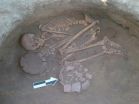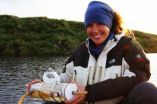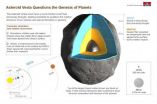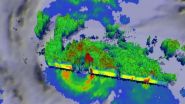(Press-News.org) In a world-first study published today, researchers say dredging activity near coral reefs can increase the frequency of diseases affecting corals.
"At dredging sites, we found more than twice as much coral disease than at our control sites," says the lead author of the study, Joe Pollock, a PhD candidate from the ARC Centre of Excellence for Coral Reef Studies (Coral CoE) at James Cook University (JCU) and the Australian Institute of Marine Science (AIMS).
"Corals require both light and food to survive," Pollock explains. "And unfortunately, dredging impacts corals on two fronts: increased turbidity means less light for photosynthesis, while increased levels of sediment falling onto the coral can interfere with their ability to feed."
Already low on energy, the corals then must spend further energy cleaning the extra sediment from their surface. Such an energy imbalance can lead to chronic coral stress.
"Just like in any other organism, it seems that chronic stress can lead to increased levels of disease in corals," Pollock says.
In the past 20 years, the frequency of coral disease has risen across the world, and has become a significant factor in global coral reef decline. In the Caribbean, disease has diminished coral cover by as much as 95 percent in some locations.
This is the first study to examine the link between dredging and coral disease in nature. It was conducted near Barrow Island, off the West Australian coast. The site is close to where an 18-month, 7-million cubic metre dredging project took place, developing a channel to accommodate ships transporting liquefied gas to a nearby processing plant. The site was in otherwise very good condition.
The most common diseases affecting corals after dredging events are the 'white syndromes', where the coral tissues fall off, leaving behind exposed, white coral skeletons. These coral diseases are chronic, and there are fears that they may linger well after the completion of dredging operations.
Dr Britta Schaffelke from AIMS, a co-author on the study, says numerous environmental stressors have been suggested as potential drivers of coral disease.
"Turbidity and sedimentation are critical pressures on the health of coral reefs and are affected by many human activities, especially in the coastal zone," Schaffelke says.
"What this study does is highlight a direct link of coral disease to sedimentation and turbidity."
Coastal industries provide economic stability, food security and reliable energy to billions of people around the world. As the pace of coastal development and demand for larger harbours escalates, the impact of elevated sediment and turbidity on the health of marine species is now a worldwide concern.
"Dredging is a pressing issue on many coral reefs throughout the world, including the Great Barrier Reef," says Pollock.
"A solid understanding of the impacts of dredging, sediment and turbidity on coral health will be indispensable in the development of well-informed management and monitoring strategies for vulnerable coral reef ecosystems," he concludes.
INFORMATION:
PAPER & IMAGES
Sediment and turbidity associated with offshore dredging increase coral disease prevalence on nearby reefs by Frederic Joseph Pollock, Joleah B Lamb, Stuart N Field, Scott F Heron, Britta Schaffelke, George Shedrawi, David G Bourne and Bette L Willis appears in PLoS ONE: http://dx.plos.org/10.1371/journal.pone.0102498
Images:
Video and more images are available on request
CONTACTS
Joe Pollock, (07) 5641 2342, Frederic.Pollock1@jcu.edu.au
Britta Schaffelke, 0427 029 464, B.Schaffelke@aims.gov.au
Jenny Lappin, Coral CoE, (07) 4781 4222, jennifer.lappin@jcu.edu.au
Melissa Lyne, media liaison, 0415 514 328, Melissa.lyne@gmail.com
New study links dredging to diseased corals
2014-07-16
ELSE PRESS RELEASES FROM THIS DATE:
Tooth plaque provides unique insights into our prehistoric ancestors' diet
2014-07-16
This news release is available in French. This news release is available in French. This news release is available in French.
An international team of researchers has found new evidence that our prehistoric ancestors had a detailed understanding of plants long before the development of agriculture.
By extracting chemical compounds and microfossils from dental calculus (calcified dental plaque) from ancient teeth, the researchers were able to provide an entirely new perspective on our ancestors' diets. Their research suggests that purple nut sedge (Cyperus ...
Tooth plaque provides insight into our prehistoric ancestors' diet
2014-07-16
A new study may provide evidence that our prehistoric ancestors understood plant consumption and processing long before the development of agriculture, according to a study published July 16, 2014 in the open-access journal PLOS ONE by Stephen Buckley from University of York and colleagues.
Evidence of plant consumption before the adoption of agriculture is difficult to find; such evidence is meaningful for understanding how much prehistoric people knew about the ecology and potential therapeutic properties of plants. Scientists in this study extracted and analyzed chemical ...
The 'obesity paradox': Cardiovascular mortality lowest among overweight patients
2014-07-16
Rochester, MN, July 16, 2014 – High body mass index (BMI) is associated with multiple cardiovascular diseases. However, emerging data suggest that there is an "obesity paradox," that being overweight may actually protect patients from cardiovascular mortality. Investigators have now confirmed that the risk of total mortality, cardiovascular mortality, and myocardial infarction is highest among underweight patients, while cardiovascular mortality is lowest among overweight patients, according to two reports published today in Mayo Clinic Proceedings.
Currently more than ...
Brain of world's first known predators discovered
2014-07-16
An international team of paleontologists has identified the exquisitely preserved brain in the fossil of one of the world's first known predators that lived in the Lower Cambrian, about 520 million years ago. The discovery revealed a brain that is surprisingly simple and less complex than those known from fossils of some of the animal's prey.
The find for the first time identifies the fossilized brain of what are considered the top predators of their time, a group of animals known as anomalocaridids, which translates to "abnormal shrimp." Long extinct, these fierce-looking ...
One injection stops diabetes in its tracks
2014-07-16
VIDEO:
Salk scientists explain the implications of their latest finding and how the treatment reverses symptoms of type 2 diabetes in mice without side effects.
Click here for more information.
LA JOLLA—In mice with diet-induced diabetes—the equivalent of type 2 diabetes in humans—a single injection of the protein FGF1 is enough to restore blood sugar levels to a healthy range for more than two days. The discovery by Salk scientists, published today in the journal Nature, could ...
Study: Climate-cooling arctic lakes soak up greenhouse gases
2014-07-16
New University of Alaska Fairbanks research indicates that arctic thermokarst lakes stabilize climate change by storing more greenhouse gases than they emit into the atmosphere.
Countering a widely-held view that thawing permafrost accelerates atmospheric warming, a study published this week in the scientific journal Nature suggests arctic thermokarst lakes are 'net climate coolers' when observed over longer, millennial, time scales.
"Until now, we've only thought of thermokarst lakes as positive contributors to climate warming," says lead researcher Katey Walter Anthony, ...
Scientists find way to trap, kill malaria parasite
2014-07-16
Scientists may be able to entomb the malaria parasite in a prison of its own making, researchers at Washington University School of Medicine in St. Louis report July 16 in Nature.
As it invades a red blood cell, the malaria parasite takes part of the host cell's membrane to build a protective compartment. To grow properly, steal nourishment and dump waste, the parasite then starts a series of major renovations that transform the red blood cell into a suitable home.
But the new research reveals the proteins that make these renovations must pass through a single pore ...
Asteroid Vesta to reshape theories of planet formation
2014-07-16
EPFL researchers have a better understanding of the asteroid Vesta and its internal structure, thanks to numerical simulations and data from the space mission Dawn. Their findings, published today in Nature, question contemporary models of rocky planet formation, including that of Earth.
With its 500 km diameter, the asteroid Vesta is one of the largest known planet embryos. It came into existence at the same time as the Solar System. Spurring scientific interest, NASA sent the Dawn spacecraft into Vesta's orbit for one year between July 2011 and July 2012.
Data gathered ...
NASA sees Typhoon Rammasun exit the Philippines
2014-07-16
Typhoon Rammasun passed through the central Philippines overnight and NASA satellite imagery showed that the storm's center moved into the South China Sea. NASA's TRMM satellite showed the soaking rains that Rammasun brought to the Philippines as it tracked from east to west.
Before Rammasun made landfall, the Tropical Rainfall Measuring Mission or TRMM satellite passed over the storm and measured cloud heights and rainfall rates. On July 14, 2014 at 18:19 UTC (2:19 p.m. EDT), TRMM spotted powerful, high thunderstorms reaching heights of almost 17km (10.5 miles). Rain ...
Researchers demonstrate health risks posed by 'third hand' tobacco smoke
2014-07-16
Research led by the University of York has highlighted the potential cancer risk in non-smokers – particularly young children – of tobacco smoke gases and particles deposited to surfaces and dust in the home.
Until now, the risks of this exposure known as 'third hand tobacco smoke' have been highly uncertain and not considered in public policy.
However, a new study published in the journal Environment International, has estimated for the first time the potential cancer risk by age group through non-dietary ingestion and dermal exposure to third hand smoke. The results ...






